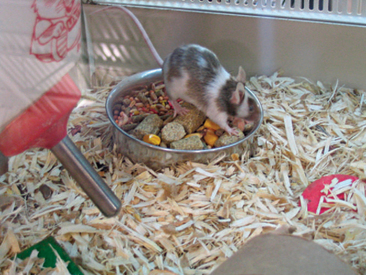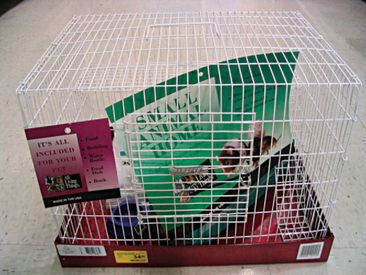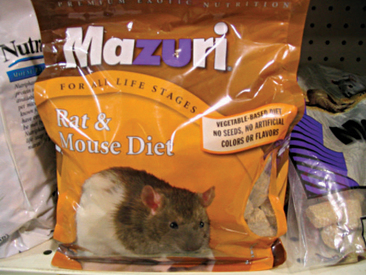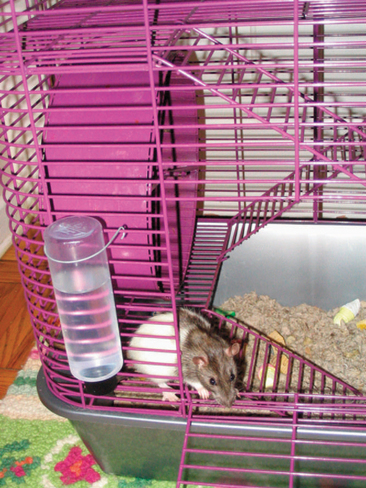CHAPTER 12 MICE AND RATS
This chapter, on mice and rats, contains information on the companion species that is useful for veterinarians treating the animals or providing information to the owners. Although similarities exist for mice and rats—in care, husbandry, diagnostic testing, and treatment—emphasis will be on the differences between the species.
MICE
Mice may be maintained as pets because of their size and playful nature. Although playful, mice can be aggressive to cagemates and owners. The aggressive nature often manifests as barbering and/or fighting with cagemates and biting their owners. Any potential owner should be educated on the ag-gressive nature of these small dynamos. Domestic mice (Mus musculus) and the African pygmy mouse (Baiomys spp.) are commonly sold for pets and are available in several varieties. The mice varieties sold in pet stores include white, black, or tan colored, satin hair coat (shiny), pied or spotted, and longhaired1,2 (Figure 12-1). The size and ability of mice to escape quickly from the grasp of a human handler make these animals, as pets, better suited for older individuals. The timid nature of mice predispose these animals to biting if handled roughly, which commonly occurs with a young owner. Mice are nocturnal animals and may be a disturbance at night if maintained in a bedroom. Female mice produce less odor than males and therefore may be more desirable as pets. As mentioned earlier, male mice are territorial, and if placed with other male mice, may fight. Advantages of having mice as pets include their size, ability to be a good companion animal for the educated (regarding mouse behavior) owner, and adorable appearance. Mice also rarely become infected with bacterial diseases, and their life span is approximately 2 years (Box 12-1).
BOX 12-1 Basic Mice Information
Modified from Bihune C, Bauck L: Basic anatomy, physiology, husbandry, and clinical techniques. In Quesenberry KE, Carpenter JW, editors: Ferrets, Rabbits and Rodents: Clinical Medicine and Surgery, ed 2, St Louis, 2004, WB Saunders; Johnson-Delaney CA, Harrison LR: Small Rodents: Exotic Companion Medicine Handbook for Veterinarians, Lake Worth, Fla, 1996, Wingers.
| Life Span | 2 years |
| Body Weight | |
| Adult male | 20-40 g |
| Adult female | 25-40 g |
| Temperature, Pulse, and Respiration | |
| Rectal/body temperature | 36.5°-38.0° C (98°–101° F) |
| Normal heart rate | 325-780 beats/min |
| Normal respiratory rate | 40-80 breaths/min |
| Amounts of Food and Water | |
| Daily food consumption | >15 g/100 g body weight/day |
| Daily water consumption | >15 ml/100 g body weight/day |
| Age at Onset of Puberty and Breeding Initiation | |
| Puberty females | 28-40 days |
| Breeding initiation males | 50 days |
| Breeding initiation females | 50-60 days |
| Female Reproductive Cycle | |
| Estrous cycle | 4-5 days |
| Gestation length | 19-21 days |
| Litter size | 10-12 |
| Postpartum estrus | Fertile |
| Young production | 8 months |
BIOLOGY
Neoplasia is a disease condition that affects mice. There are some mouse strains in which mouse mammary tumor viruses have been identified that have a neoplasia incidence as high as 70%.3 Tumor viruses, as well as a very short life span (up to 2 years), predispose these animals to cancer. Mammary adenocarcinomas and fibrosarcomas are the most common tumors that affect mouse mammary tissue.4 Unfortunately, by the time many of these tumors are diagnosed, the malignant masses are large and ulcerated.4 Fibrosarcomas may be hormonally induced, and the incidence of this disease process can be reduced through an ovariectomy at an early age. The small size of the female mouse often makes the ovariectomy surgery challenging for the veterinary surgeon.
Although relatively uncommon, urethral obstruction can occur in male mice as a result of preputial and/or bulbourethral gland infections.4 Male mice suffering from an urethral obstruction may have a mutilated penis, a sign often associated with the disease process.
Mice are continuous, polyestrous rodents that should be bred in polygamous or monogamous setups because of the males’ aggressive territoriality behavior.2 When breeding mice that have been housed in a polygamous ratio, there may be one male with two to six females.2 Females are removed from a polygamous cage before parturition, whereas the monogamous pair is maintained together with the young until weaning.2
HUSBANDRY
Environmental Considerations
Mice are maintained in environments that are similar to other small rodents but require a thorough cleaning of their cage more often because of their malodorous urine. Ventilation is essential for small rodent housing to prevent irritation of the respiratory tract from ammonia vapors generated by urine. The recommended housing unit for mice is 12-15″ ×12-15″ ×6″ (length ×width ×height) for each adult mouse; females and young require 2 to 3 times the space listed.2 The major considerations for selecting an enclosure for mice is that it be resistant to their escape and easy to clean. An open screen top of the enclosure is recommended for proper ventilation. Available rodent cages that fit this criterion are wire or metal mesh, plastic, and Plexiglas. If the plastic tube housing systems are used, there should be routine cleaning of the sections using hot water and a mild detergent. Owners should be informed of the small distance required for a mouse to escape and their ability to chew through plastic. An owner must always monitor the cage for possible escape avenues, especially if the animal has a predilection for modifying the cage opening through chewing. It is very important to provide cage toys and exercise opportunities for mice. The enclosure should be large enough to house not only food and water containers but also cage toys and an exercise wheel (Figure 12-2). Although not a cage toy, a hide box, in some form, should also be included for the psychological well-being of the animal. This hide box can be manufactured or a small cardboard container that has one end cut out. Mice like to hide and also sleep during the day. This piece of cage furniture will enable the mouse to sleep undisturbed during the daylight hours.
Mice, especially males, have odiferous urine. To prevent the buildup of urine and fecal material in the cage, commercially available paper rodent bedding or hardwood shavings should be used as a cage substrate. Although softwood (pine) and cedar shavings are available, the volatile oils that radiate from these substrates are irritating to small animals. These irritating compounds can cause dermal and respiratory inflammation, often leading to secondary bacterial infections.
Temperature, humidity, and lighting within the enclosure should follow what is commonly maintained with the ambient conditions within the house. If the animals are housed outside or in an outbuilding, the temperature range should be 65° F to 85° F and humidity 30% to 70%, although the recommended humidity is on the higher end of the range provided.2 Mice, especially males, are extremely territorial animals. If mice are housed alone, it is better to keep them separate, as introduction of new animals will often lead to aggression and fighting. To prevent aggression, fighting, and psychologically induced adverse behavior (e.g., barbering), a single mouse is recommended as a companion animal. For those who intend to breed the animals, enclosures with a single pair is necessary for reproductive success.
Nutrition
Because mice are commonly used as laboratory animals in investigations of human disease processes, much research literature is available on the recommended nutritional requirements of these animals. The benefit of these dietary studies is the availability of commercially produced diets that provide the recommended daily nutritional requirements of the mouse. The problem that most owners face is the multitude of dietary products available for mice and the lack of knowledge regarding which food to buy. Most new mouse owners think that rodents eat seed-based diets. Although mice will happily eat seed, seed-based diets are lacking in a number of the nutritional requirements needed to maintain long-term health. Commercial rodent biscuits or pellets with more than 14% protein are the recommended diets for mice.2 The commercial rodent biscuits or pellets are the only food mice need to obtain their required nutrients (Figure 12-3). Again, seed-based diets are not recommended, nor is a significant supplementation of fruits, nuts, vegetables, cheese, or other human foods (e.g., peanut butter). If a treat is to be given, yogurt or dried fruit treats manufactured specifically for rodents and/or mice should be provided 2 to 3 times a week. For younger mice, less than 3 weeks old, softer pellets are needed because babies start eating pellets and drinking water at 2 to 3 weeks of age.2 A sipper bottle, placed on the outside of the cage, is easy to maintain and does not take any space within the enclosure. If the cage is plastic or Plexiglas, modifications will be needed to attach the sipper bottle on the outside of the cage. Most sipper bottles come with attachment hardware to attach to wire cages (Figure 12-4). Fresh bottled water is recommended for mice, although chlorinated tap water is acceptable. The water should be checked on a daily basis and clean water supplied at least every 2 days, if not every day.
PREVENTIVE MEDICINE
Quarantine
Quarantining an animal is important when a new animal is being introduced into a setting in which there is an established group. As with other animals, a 30-day quarantine period is recommended, along with a physical examination and fecal parasite check. Unfortunately, there is no time period that will screen 100% against potential infectious agents, and with mice, time is critical because their life span and reproductive time frame are so short. The animals should be quarantined in conditions similar to those in which they will be permanently maintained. Providing adequate food and water will make for a smooth transition. It is imperative that the owner screen the new animal for diseases and watch for any signs of illness. The most common sign of clinical illness is a rough hair coat. The lack of grooming is most often related to the animal feeling depressed or sick, thereby not having the energy to perform routine behaviors. If a number of animals are being quarantined, sacrificing an apparently diseased animal is the most efficient way to determine a rapid definitive diagnosis. If it is a single or an expensive animal, routine diagnostic testing will be required.
To maintain oversight of breeding animals’ health and reduce the exposure of young animals to infectious disease and parasites, routine screening of representative animals within the colony is recommended. In very large colonies, special caging (e.g., filter), food, and water may be necessary to prevent exposure to disease organisms.2
Routine Exams
RESTRAINT
To catch a mouse, the tail should be grabbed with the thumb and forefinger, allowing the mouse to hold on to an object with their front feet (Figure 12-5). When the mouse securely attaches itself to an object, the opposite hand then grabs the dorsal skin in the cervical region while keeping the tail in a firm grasp.
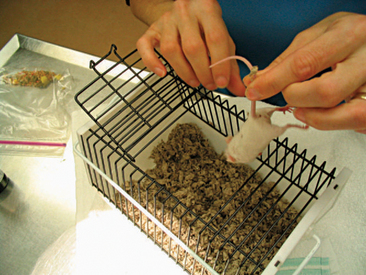
Figure 12-5 By grasping a mouse by the tail and slowly dragging over a cage, the mouse can be positioned for capture.
HISTORY
Typical background information required includes how long the mouse been owned, where it was acquired, how often it is handled, and what the character of the feces and urine is. Husbandry questions should focus on the animal’s housing and whether it is allowed to roam unobserved; cage location; type, size, and material of the cage; cage substrate, furniture, and toys; and the frequency with which the cage is cleaned and what disinfectant is used. When investigating the diet, the veterinarian should ask not only if pellets are fed and in what quantity, but also what the animal is eating and what the primary diet is. Supplemental offerings and frequency of feeding are important data for the case work-up. The veterinarian should find out about the water supply, how often the water is changed, and how much the animal drinks on a daily basis.
COMMON ABNORMALITIES FOUND ON PHYSICAL EXAMINATION
Most of the common problems noted during the physical examination of mice involve the skin and hair coat. As mentioned previously, an unkempt hair coat may point toward generalized illness or external parasitism. Abrasive lesions or pustules on the skin can be signs of external parasites or infectious dermatitis. If external parasites are a problem, the mouse may be uncontrollably scratching. Hair loss may be associated with barbering, either cagemate or self-induced, or with infection (e.g., ringworm). Although not common, Trichophyton mentagrophytes will cause hair loss in mice, from the face, head, and neck.4
As with many rodents, respiratory disease is commonly identified in mice. Mice may have presenting symptoms of dyspnea, sneezing, coughing, chattering, and sniffling if they have a respiratory infection. In cases where respiratory signs are observed, anesthetizing the animal to perform the physical examination is not recommended, and handling should be kept to a minimum. The two most common respiratory disease conditions in mice are Sendai virus and Mycoplasma pulmonis.4 These two organisms are very difficult to identify through routine diagnostic measures, and obtaining samples significantly stresses the patient. If the animal is being examined for placement into a colony or breeding environment, sacrifice to identify the disease condition is recommended. If the animal is an individual companion animal, doxycycline treatment should be initiated. Although treatment with doxycycline will not clear the organism from the animal, it will reduce clinical disease and improve the quality of life. The treated animal should always be considered a carrier of these respiratory diseases if a definitive diagnosis cannot be obtained.
Male mice that are licking and/or mutilating their penis may be suffering from a urethral obstruction. Infection of accessory sex glands, young males with aggressive breeding activity, urolithiasis, and trauma may initiate this self-induced trauma to the penis.4 Pasteurella pneumotropica is often isolated from accessory sex gland infections as well as subdermal abscesses.4 Treatment for this organism may aid in the recovery of a mouse affected by urethral obstruction.
Diarrhea in mice is rare, but endoparasite examinations should be performed if the animal has diarrhea. Although pinworms are considered nonpathogenic in mice, Syphacia obvelata and Aspiculuris tetraptera may cause rectal prolapse due to straining in immunosuppressed individuals.5 As with other animals, a tape test is the best way to identify these parasites. A tape test follows a procedure of pressing the sticky side of the tape against the rectum and perianal area and then examining the tape under a microscope for eggs and parasites.5
DIAGNOSTIC TESTING
Hematology
As with other pocket pets, blood collection from mice can be quite difficult. Approximately 0.5 to 0.7 ml/100 g body weight can be safely removed from a nonanemic healthy mouse.2 The mouse patient should always be anesthetized for blood collection procedures. Usually inducing the animals in a closed chamber and maintaining the patients in a mask will allow the technician plenty of time to collect the blood sample. A small, 25-, 26-, or 30-gauge needle, usually placed on a 1-ml syringe, is recommended for collecting the blood. Recommended blood collection sites in a mouse are a warmed ventral tail vein or the tip of the tail.2 Box 12-2 describes the technique used for retroorbital bleeding in mice. The retroorbital bleeding technique is commonly used in laboratory animal settings and is easily performed by an experienced veterinarian or veterinary technician.5

BOX 12-2 Retroorbital Blood Collection for Mice
Rights were not granted to include this box in electronic media. Please refer to the printed book.
From Tully TN, Mitchell MA: A Technician’s Guide to Exotic Animal Care, Lakewood, CO, 2001, American Animal Hospital Association Press.
On smaller rodents, the saphenous vein or lateral vein of the tarsus may be used for multiple blood collections without the use of anesthesia. The patient must be properly immobilized in a restraint tube (35-ml syringe) with the leg extended and the skin held tight on the medial aspect of the thigh using the thumb and forefinger.2 The taut skin on the lateral aspect of the thigh allows exposure of the saphenous vein. A 23-gauge needle is used to puncture the vein, and blood is collected in a microhematocrit tube as it flows from the vessel.5
Blood samples obtained from nail and ear clips are not considered appropriate diagnostic samples. Cardiac puncture is recommended only in terminal cases and when the animal is maintained under general anesthesia because of possible complications involving the lungs and heart vessels. Reference ranges for complete blood counts and serum biochemistry panels for mice are listed in Boxes 12-3 and 12-4.1,2
BOX 12-3 Complete Blood Count Reference Ranges for Mice
| Erythrocytes | 7-12.5 × 106 μL |
| Hematocrit | 36%-39% |
| Hemoglobin | 10.2-18 mg/dl |
| Leukocytes | 6-15 × 103 μL |
| Neutrophils | 10%-40% |
| Lymphocytes | 55%-95% |
| Monocytes | 0.1%-3.5% |
| Eosinophils | 0%-4% |
| Basophils | 0%-0.3% |
| Platelets | 160-410 × 106 mm3 |
| Serum protein | 3.5-7.2 g/dl |
| Albumin | 2.5-4.8 g/dl |
| Globulin | 1.8-3 g/dl |
BOX 12-4 Serum Biochemistry Reference Ranges for Mice
| Serum glucose | 62-175 mg/dl |
| Blood urea nitrogen | 12-28 mg/dl |
| Creatinine | 0.3-1.0 mg/dl |
| Total bilirubin | 0.1-0.60 mg/dl |
| Cholesterol | 26-82 mg/dl |
| Serum calcium | 8.0-12.0 mg/dl |
| Serum phosphorus | 3.0-6.0 mg/dl |
Bone Marrow Aspiration
Marrow samples may be obtained from the ilium, tibia, sternum, femur, or the bones of the proximal one third of the tail.5 Preparation of the samples is consistent with that of other mammalian patients.
Urine Collection
Standard rodent cages can be used without substrate to collect urine and feces when the patient is hospitalized. After placing a rodent in a zip-lock bag, urination frequently occurs and the sample can be collected.4 In a similar manner, urine can be collected over a disinfected stainless steel examination table. The urine is voided while the animal is restrained and can be collected in a capillary tube for evaluation on urine reagent strips.1 Urinalysis reference values for mice are listed in Box 12-5.
BOX 12-5 Urinalysis Reference Values for Mice
From Bihune C, Bauck L: Basic anatomy, physiology, husbandry, and clinical techniques. In Quesenberry KE, Carpenter JW, editors: Ferrets, Rabbits and Rodents: Clinical Medicine and Surgery, ed 2, St Louis, 2004, WB Saunders.
| Urine volume (ml/24h) | 0.5-2.5 ml |
| Specific gravity | 1.034 |
| Average pH | 5.01 |
| Protein | males proteinuric |
Diagnostic Imaging
Under most practice settings, the size of a mouse patient limits imaging capabilities to radiographs. Restraint is essential for quality diagnostic images and is even more important when patients weigh as little as 40 g. To obtain adequate restraint and prevent movement of the mouse patient during radiographic evaluation, sedation is required. As with all diagnostic procedures involving avian and exotic animals, an evaluation of the patient is required to determine its ability to withstand the stress associated with the assessment. If it is determined that the patient cannot withstand sedation, then it should be stabilized until it is deemed healthy enough for diagnostic imaging evaluation.
Sedating the mouse using an induction chamber and isoflurane anesthetic, as described for restraint, is necessary to obtain diagnostic films. High-speed, 300-mA machines with fine or detail-intensifying screens should be adequate for most small exotic mammal images. With mice, dental x-ray units that can focus at short distances may be advantageous for both isolation of focal anatomy and full body radiographs in extremely small patients. For extreme detail in small exotic mammal medicine, using a traditional radiography unit, the Min R mammography system (Eastman Kodak) with Min R single-intensifying screen cassettes, in conjunction with Min R single-emulsion film, has been recommended.1 Digital radiography is bringing a new dimension to radiograph evaluations and detail. The secret to success in either traditional or digital radiographic imaging is to restrict patient movement during exposure. Two views, ventrodorsal and lateral, are recommend for mice patients. Again, because of a mouse patient’s size, whole body radiographs are commonly obtained during the radiographic evaluation, even using dental radiographic equipment.
Parasitology
Diagnosis of ectoparasites in small rodents is similar to that in other species listed in this text. The pelage tape test is performed by pressing clear cellophane tape against the pelt of a mouse, dorsally and ventrally, from the nose to the base of the tail. Myobia spp. and Myocoptes spp. can be diagnosed using the pelage tape test. A skin scraping of the affected area may also help in identifying ectoparasites. Diagnosis of intestinal parasites can be made by finding individual eggs during fecal examination or whole worms within the lumen of the small intestine during necropsy.6
Stay updated, free articles. Join our Telegram channel

Full access? Get Clinical Tree


